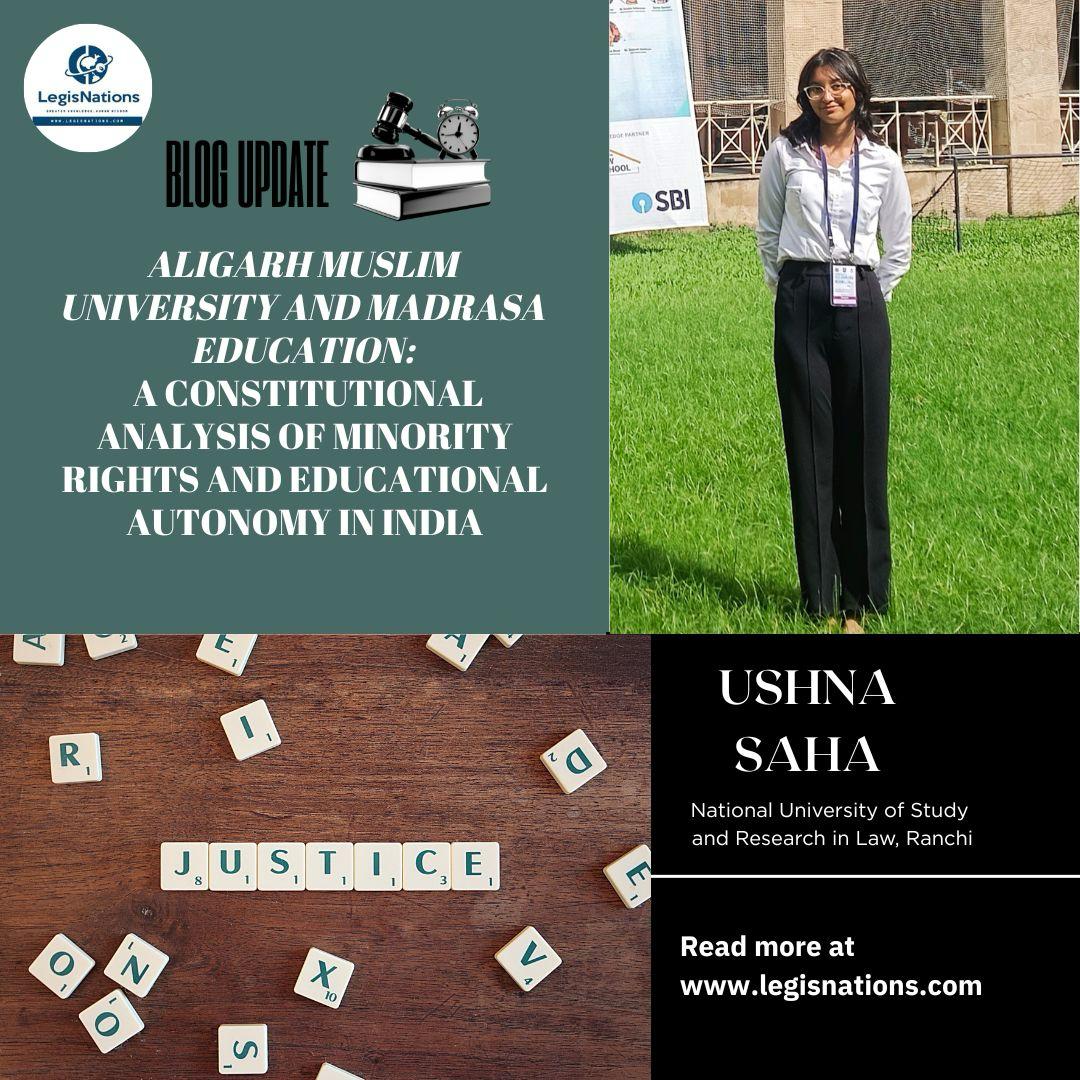Introduction
The constitutional status of minority educational institutions like Aligarh Muslim University (AMU) and madrasas remains a contentious issue in India. Article 30 of the Indian Constitution grants minorities the right to establish and administer educational institutions of their choice, but its interpretation has evolved significantly through judicial rulings. The recent 2024 Supreme Court verdict reaffirming AMU’s minority status has sparked renewed debate on the balance between minority rights and state regulation.
This paper delves into the historical, legal, and socio-political aspects of this issue, analyzing landmark judgments, policy implications, and comparative international perspectives. It also explores the modernization of madrasa education and the broader impact of such reforms on India’s educational landscape. By examining the historical evolution of Article 30, this study aims to highlight the tensions between constitutional protections for minorities and broader principles of equity and inclusion in education.
The Evolution of Minority Educational Rights in India
Colonial Foundations and Post-Independence Developments
The foundation for minority educational institutions was laid during British rule when religious communities established institutions to preserve their cultural identity. The British education system, largely influenced by Christian missionary activities, led to the establishment of various religious schools by different communities seeking to protect their traditions. Post-independence, Article 30 was incorporated into the Constitution to ensure that religious and linguistic minorities could continue to establish and administer their institutions without undue state interference.
Landmark Judicial Interpretations
- State of Bombay v. Bombay Education Society (1954)[1]: Affirmed minority institutions’ right to manage admissions and curriculum.
- Re Kerala Education Bill (1957)[2]: Upheld the state’s right to regulate minority institutions while preserving their autonomy.
- Azeez Basha v. Union of India (1968)[3]: Denied AMU’s minority status, arguing it was established by a legislative act rather than directly by the Muslim community.
- St. Xavier’s College v. State of Gujarat (1974)[4]: Emphasized the autonomy of minority institutions in administrative matters.
- T.M.A. Pai Foundation v. State of Karnataka (2002)[5]: Expanded the definition of minority institutions and emphasized state-level determination of minority status.
- P.A. Inamdar v. State of Maharashtra (2005)[6]: Affirmed that state-imposed reservations do not apply to private unaided minority institutions.
- Pramati Educational & Cultural Trust v. Union of India (2014)[7]: Exempted minority institutions from the Right to Education (RTE) Act.
- Anjum Kadari vs Union Of India[8]: Overturned the 1968 ruling, reinstating AMU’s minority status and broadening the interpretation of Article 30.
AMU’s Minority Status: Reaffirmation and Implications
The 2024 Supreme Court judgment recognized AMU as a minority institution, reversing decades of legal uncertainty. The ruling emphasized:
- The historical establishment of AMU for the Muslim community.
- The principle that legal recognition via statute does not negate an institution’s minority status.
- The reaffirmation of the right of minority institutions to reserve up to 50% of seats for community members.
This decision sets a precedent for similar institutions seeking minority status and ensures their autonomy in managing administrative and academic affairs. However, it also raises questions about the balance between constitutional protections and broader considerations of equity and inclusion in higher education.
- Reinterpretation of Article 30: The majority verdict provided a liberal interpretation of Article 30, stating that educational institutions established prior to the adoption of the Constitution are equally entitled to the protections granted under Article 30(1). This means that AMU, despite being established through a central legislation, could still claim minority status.
- Autonomy and Minority Character: The court emphasized that the minority character of an institution should not be rejected merely because its administration is regulated by a statute. This ruling was significant as it allowed AMU to maintain its autonomy and continue to reserve up to 50% of seats for Muslim students.
- Implications for Other Institutions: The verdict set a precedent for other institutions seeking minority status, clarifying that statutory enactments conferring legal recognition do not negate an institution’s minority status.[9]
The dissenting judges argued that the 1967 ruling should be upheld, maintaining that AMU’s establishment through central legislation disqualified it from being considered a minority institution. They contended that the 1981 amendment, which recognized AMU’s minority status, was not sufficient to override the original Supreme Court decision.
The 2024 Supreme Court decision marked a significant shift in the interpretation of Article 30, reaffirming the rights of minority institutions to maintain their autonomy and cultural identity. This ruling has far-reaching implications for the educational landscape in India, ensuring that minority institutions can continue to operate without undue interference from the state.
Balancing Minority Rights and Educational Equity
While Article 30 grants minority institutions autonomy, it also exempts them from affirmative action policies under Articles 15(4) and 15(5). This exemption raises concerns about access to educational opportunities for marginalized groups outside the minority community.
Recommendations And Suggestions
The lack of clear criteria for determining minority status under Article 30 has led to confusion and disputes, such as the ongoing debates over Aligarh Muslim University’s (AMU) minority status. This ambiguity undermines judicial efficiency and erodes trust in institutions. To resolve this, the government and judiciary should collaborate to create transparent and objective guidelines for identifying minority status. These guidelines could be based on factors like historical evidence of establishment by minority communities, the institution’s role in preserving cultural identity, and its contributions to community welfare. Clear, standardized criteria would ensure consistency across states, reduce litigation, and prevent arbitrary decisions. For institutions like AMU, this clarity could simplify the recognition process and avoid prolonged legal battles.
While Article 30 guarantees autonomy to minority institutions, complete independence without accountability can sometimes hinder the quality and equity of education. State-funded institutions, in particular, should follow reasonable regulations to ensure their operations align with national educational goals. These regulations could involve maintaining academic standards, conducting transparent financial audits, and implementing fair access policies. However, such measures must respect the cultural and religious identity of these institutions. A framework of conditional autonomy would balance the preservation of their unique character with the need for accountability. For example, St. Stephen’s College could maintain its distinctiveness while adhering to inclusive admission practices under this approach.
Madrasas play a crucial role in educating the Muslim community, but they face challenges in adapting to modern educational needs. Incorporating secular subjects like mathematics, science, and languages can improve the employability of their graduates and align their curriculum with current demands. These reforms should be voluntary and developed in consultation with the community to ensure respect for their religious and cultural traditions. Government support, such as funding for infrastructure and teacher training, could facilitate this process without imposing rigid conditions. This way, madrasas can preserve their cultural mission while equipping students for broader career opportunities.
Although minority institutions have the constitutional right to prioritize members of their own communities, their exclusion from broader affirmative action policies might unintentionally increase socio-economic disparities. Encouraging voluntary measures, such as reserving a small portion of seats for economically disadvantaged individuals from outside their community, could balance autonomy with inclusivity. To support this, the government could provide incentives like grants or awards for inclusive practices. By adopting such policies, institutions like AMU and Jamia Millia Islamia could enhance their societal impact and contribute to a more equitable education system.
Distrust and misunderstandings surrounding minority institutions often arise from inadequate communication among communities, the state, and these institutions. Public perceptions about madrasas or debates on AMU’s minority status are frequently influenced by stereotypes and political narratives, deepening divisions and resistance to change. Establishing formal platforms for dialogue—bringing together policymakers, educators, and community leaders—could address these challenges. Such forums would promote transparency, foster mutual trust, and ensure that reforms are collaboratively designed and effectively implemented.
Conclusion
The reaffirmation of AMU’s minority status marks a significant milestone in the legal interpretation of Article 30. However, the broader issue of minority educational rights requires a nuanced approach that balances constitutional protections with inclusivity. Transparent policies, voluntary modernization of madrasa education, and equitable admission frameworks can help foster a more inclusive and robust educational landscape in India.
By ensuring that minority institutions retain their autonomy while remaining accountable to national educational standards, India can uphold its
[1] State of Bombay v. Bombay Education Society 1954 AIR 561,
[2] In re Kerala Education Bill, 1957, 1959 1 SCR 995
[3] Azeez Basha v. Union of India, AIR 1968 SC 662
[4] The Ahmedabad St. Xavier’s College Society & Anr. v. State of Gujarat & Anr., AIR 1389, 1975 SCR (1) 173
[5] T.M.A. Pai Foundation & Ors. v. State of Karnataka & Ors., AIR 2003 SC 355
[6] State of Bombay v. Bombay Education Society, AIR 1954 SC 561
[7] Pramati Educational & Cultural Trust & Ors. v. Union of India & Ors., (2014) 8 SCC 1
[8] Anjum Kadari vs Union Of India 2024 INSC 831
[9] ibid


